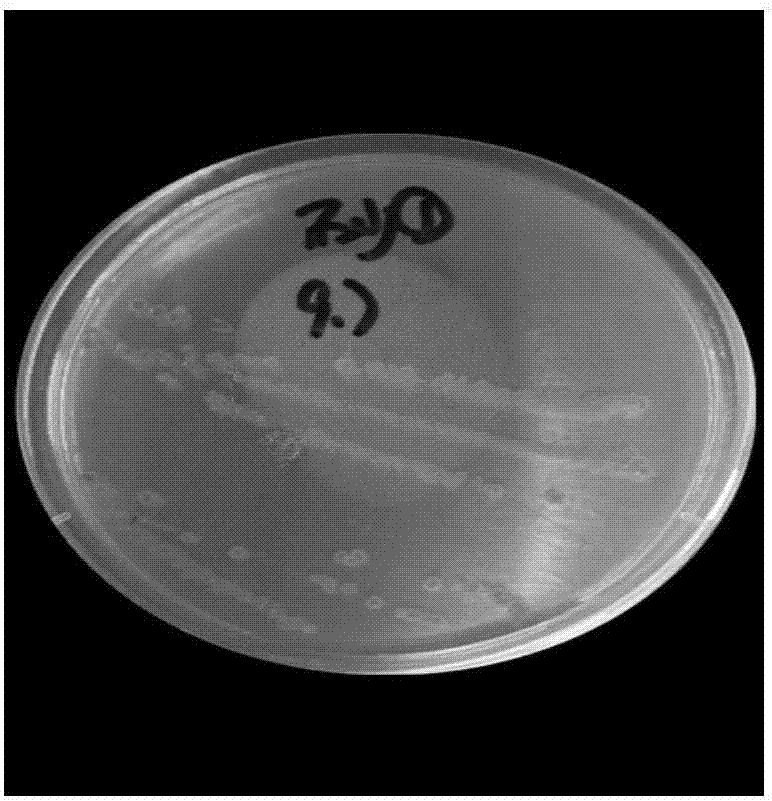Method for screening and separating chlorine-resistant bacteria and Gordonia terrae strain obtained with same
A separation method and chlorine-resistant technology, applied in the directions of microorganism-based methods, separation microorganisms, biochemical equipment and methods, etc., can solve problems such as screening and separation of chlorine-resistant bacteria, and achieve the effect of ensuring biological safety.
- Summary
- Abstract
- Description
- Claims
- Application Information
AI Technical Summary
Problems solved by technology
Method used
Image
Examples
Embodiment 1
[0030] Example 1 Taking pipe network water as an example, screening and separating chlorine-resistant bacteria therein
[0031] (1) Take 1L of water sample from a pipe network, enrich and concentrate the water sample through a 0.22μm polycarbonate membrane, then add 5mL of normal saline to elute, centrifuge at 3500rpm, discard the supernatant, collect the bacteria, and the collected bacteria Add 5 mL of nutrient broth and place in a water-proof incubator at 37°C for 24 hours. Centrifuge the cultured bacterial solution at 3500 rpm for 10 min, discard the supernatant, add 10 mL of normal saline and vortex to prepare a bacterial suspension for later use.
[0032] (2) Chlorination test was carried out on the bacterial suspension, the theoretical amount of chlorine added was 9mg / L, and HPC was measured at 30min, 1h, and 2h respectively to ensure that the residual chlorine in water was greater than 0.5mg / L during HPC measurement. Using R 2 A medium plate coating method was used fo...
Embodiment 2
[0044] This specific example uses the following steps:
[0045] (1) Weigh 10g of biological sand in a sand filter tank of a water plant, add 50mL of normal saline, and then 40KHz ultrasonic elution for 10min, 800rpm, centrifuge for 10min, take the supernatant and repeat the above centrifugation steps twice, take the supernatant and centrifuge at 3500rpm for 10min and discard it Add 10 mL of normal saline to the supernatant and vortex to prepare a bacterial suspension for later use.
[0046] (2) Carry out chlorination test to bacterial suspension, the theoretical concentration of chlorine after chlorination is 9mg / L, carry out HPC measurement respectively in action 30min, 1h, 2h, guarantee that the residual chlorine amount in water is greater than 0.5mg / L when HPC is measured .
[0047] (3) Using R 2 A medium plate coating method is used for HPC determination. After the coated plate is placed at 22°C for 7 days, the growth of the colony on the plate is observed, and the morph...
Embodiment 3
[0052] This specific example uses the following steps:
[0053] (1) Weigh 10g of biological activated carbon from a charcoal filter of a water plant, add 50mL of normal saline, then 40KHz ultrasonic elution for 10min, 800rpm, centrifuge for 10min, take the supernatant and repeat the above centrifugation steps twice, take the supernatant and centrifuge at 3500rpm for 10min, discard the supernatant Add 10 mL of normal saline and vortex to prepare a bacterial suspension for later use.
[0054] (2) carry out chlorination test to bacterium suspension, the theoretical concentration of chlorine after chlorination is 9mg / L, carry out HPC measurement (attachment) in effect 30min, 1h, 2h respectively Figure 5 ), to ensure that the amount of residual chlorine in the water is greater than 0.5mg / L when HPC is measured.
[0055] (3) Using R 2 A medium plate coating method is used for HPC determination. After the coated plate is placed at 22°C for 7 days, the growth of the colony on the p...
PUM
| Property | Measurement | Unit |
|---|---|---|
| pore size | aaaaa | aaaaa |
Abstract
Description
Claims
Application Information
 Login to View More
Login to View More - R&D
- Intellectual Property
- Life Sciences
- Materials
- Tech Scout
- Unparalleled Data Quality
- Higher Quality Content
- 60% Fewer Hallucinations
Browse by: Latest US Patents, China's latest patents, Technical Efficacy Thesaurus, Application Domain, Technology Topic, Popular Technical Reports.
© 2025 PatSnap. All rights reserved.Legal|Privacy policy|Modern Slavery Act Transparency Statement|Sitemap|About US| Contact US: help@patsnap.com



